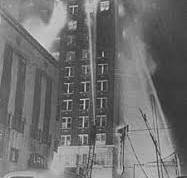History is filled with examples of humanity’s hubris leading to largely preventable disasters, where it took a staggering loss of life for safety laws and regulations to catch up with the pace of technology.
One such example is the 1946 fire at the Winecoff Hotel in Atlanta that claimed the lives of 119 people and injured more than 100. Much like the stories of the RMS Titanic and, later, the airship Hindenburg, the Winecoff Hotel fire led to sweeping changes in building practices across the nation.
Prior to the Winecoff fire, safety measures such as fire escapes and sprinkler systems were thought to be redundant and forcing the owners of public buildings to install such life saving measures amounted to overkill.
The use of asbestos as a fire retardant material had been in widespread use since the 1850s. The conventional wisdom of the time was to attempt to design buildings that would not catch fire and little thought was put into the safety protocols for when a building actually did catch fire.
The prevailing thought at the time was that if a building was designed to be “fire-proof,” then there was no need for an unsightly looking fire escape placed on the outside of the building.
Even the great fire of 1916 that occurred in Augusta and leveled much of Broad Street did not change anyone’s mind; in fact, builders would point out that no one died in the great Augusta fire as a testament to modern building techniques.
MORE: Wellstar seeks to update signage plan as Columbia County hospital construction progresses

Augusta’s first skyscraper, the Lamar Building was under construction at the time of the fire. The building easily stuck out amid the ruins of Broad Street and even though the building was gutted, construction crews basically only had to clean off the soot and continue the project.
In 1913, when the Winecoff Hotel opened to the public, Atlanta was beginning to look like a smaller version of Chicago and New York City, with towering office complexes and hotels rising into the sky.
Atlanta was a particularly popular place to build, as the Civil War had decimated the once proud southern city and what General William Sherman left behind was basically a blank canvas on top of the rubble.
William F. Winecoff had big ideas when he came to Atlanta from New York City in 1912, he planned to build a hotel that was so tall, it could be seen from all over the city. He chose the corner of Peachtree Street and Ellis Street as the location for his super luxurious hotel.
Atlanta fire codes at the time allowed for a building that large to be serviced by only one stairwell. The stairwell snaked around the main elevator shaft and that design, along with “transom” windows over the doors that could be opened for ventilation, became key elements in what made the fire such a disaster.
What was the only means of escape from the upper floors actually acted like a giant chimney sucking in air from the lower floors and pumping the smoke out through the top.
MORE: Augusta Commission votes to support keeping James Brown Arena name, OKs waste hauler
Hotel brochures, and even the hotel stationary, boasted that the building was “100% fireproof,” according to the Atlanta Journal and Constitution. While the building might have been fireproof, its contents of furniture, bedding and even the wallpaper was not immune to fire.
Winecoff, along with his wife, ran the hotel successfully for many years, but by the mid 1940s, he was looking to retire. He made a deal with the new owners that he and his wife would be given a penthouse suite on the top floor for the rest of their lives.
Under new management, the hotel remained a prestigious address, but the Augusta Constitution newspaper noted at the time the building was showing its age and had begun to attract less and less of the elite and was more inviting to “ladies of the night.”
The only call made to the Atlanta Fire Department came shortly after 3:15 a.m. on Dec. 7, 1946 after a bellboy noticed smoke coming from a mattress being stored in the stairwell. Officials later concluded that a carelessly discarded cigarette was to blame for starting the blaze, which quickly spread to the upper floors.
After calling the fire department, the night manager of the hotel discovered that the fire alarm system was inoperable and he desperately began calling occupants room-by-room. However, due to the building’s construction, the manager’s actions were mostly in vain as everyone above the third floor was trapped.
Upon arrival, fire department officials discovered that their ladders were too short to do much good and firefighters on the scene were also hampered by falling bodies of those who preferred to jump rather than be burned alive in the towering inferno.
Associated Press reporter E.J. Hosch witnessed four women leap to their deaths, while other guests tied bed sheets together to create “fragile lifelines” that hung from windows.
Helpless witnesses could hear the screams of the dying coming from inside of the burning hulk.
In the aftermath of the fire, Atlanta and other major cities reviewed their building codes and the results are the modern safety devices seen daily in high rises across the nation.
Just as the Titanic dispelled the notion of the “unsinkable ship,” the Winecoff fire similarly did away with the idea of the “fireproof building.”
…And that is something you may not have known.
Scott Hudson is the Senior Investigative Reporter, Editorial Page Editor and weekly columnist for The Augusta Press. Reach him at scott@theaugustapress.com










